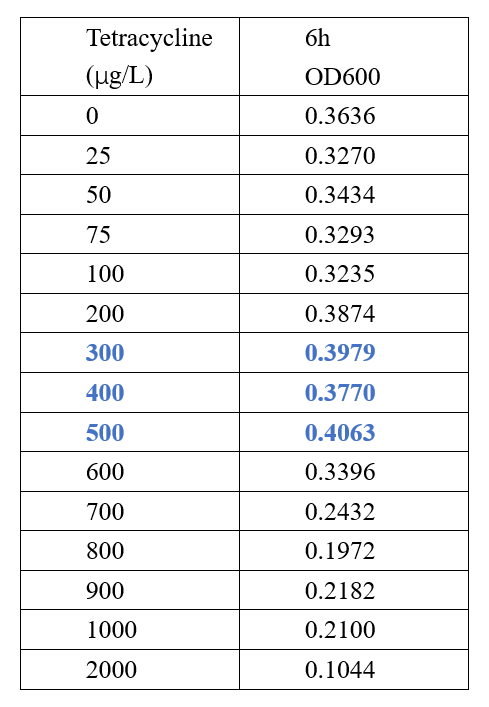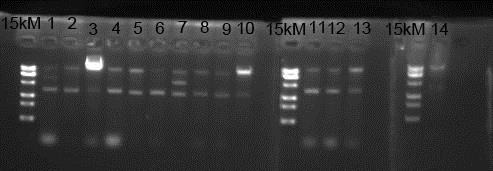Part:BBa_I12219
Wild-type TetR(B) promoter (negative)
- 10COMPATIBLE WITH RFC[10]
- 12COMPATIBLE WITH RFC[12]
- 21COMPATIBLE WITH RFC[21]
- 23COMPATIBLE WITH RFC[23]
- 25COMPATIBLE WITH RFC[25]
- 1000COMPATIBLE WITH RFC[1000]
Characterization by 2021iGEM_Shanghai_Metro
Improvement of an existing part
Compared to the old part BBa_K613000, a medium-strength Plac promoter, and the old part BBa_I12219, a wild-type TetR(B) promoter, we design a new part BBa_K4028009, which contains the two old promoters and two totally new protein tke4, ike4. The tke4 protein is a toxic Rhs-type effector in the type VI secretion system (T6SS). The ike4 protein is an immune protein that can counteract the damage caused by toxic effector factors tke4.
The group iGEM11_EPFL aimed to characterize the Plac promoter by coupling it to RFP. The normal expression of RFP driven by their Plac promoter is 530 normalized RFUs and the highest value is 640 normalized RFUs. The group iGEM2004_ Antiquity just upload some information about the TetR promoter.
Based on the two groups’ contribution, our team design the new composite part BBa_K4028009 to express tke4 regulated by Plac promoter and ike4 regulated by TetR promoter. After the composite part was inserted in a particular plasmid vector and entered an industrial bacteria. The normal growth of industrial microorganisms can be ensured only by adding certain components (tetracycline) in the fermentation broth, so as to achieve the purpose of our project.
First of all, we constructed a composite part BBa_K4028009 and transformed it into E.coli DH5α. We successfully expressed tke4 protein constitutively and expressed ike4 protein induced by adding tetracycline.
Furthermore, we set different tetracycline concentrations to test the protein expression induced by TetR(B) promoter. In our design, the immune protein (ike4) is regulated by TetR(B) promoter. The expression of the immune protein (ike4) directly affects and is positively correlated with strain growth. Therefore, the strain growth can indicate the regulation of the TetR(B) promoter.
The results of the test are below.
The results show that concentrations at the range of 300-500µg/L are more effective. The results also proved that adding tetracycline to the strain will boost the growth of the strain. It determines that the optimal concentration of tetracycline is 300µg/L to 500µg/L.
In addition, our project can serve lots of industrial biofactory companies. The recommended particularly component concentration range could be used for the application of their patented-strain protection technology. Therefore, our engineering strain has a huge potential commercial market.
Profile
Name: lac pro-tke4-tet pro-ike4
Base Pairs: 5208 bp
Origin: Escherichia coli, Pseudomonas putida KT2440, synthetic
Properties: Gene technology for protecting patented bacterial strains
Usage and Biology
A wide range of Gram-negative bacteria have been shown to have antibacterial T6SSs, including opportunistic pathogens such as Pseudomonas aeruginosa,[4] obligate commensal species that inhabit the human gut (Bacteroides spp.),[5] and plant-associated bacteria such as Agrobacterium tumefaciens.[6] Under natural conditions, bacterial cells encoding T6SS transport effect factors with cytotoxic or antibacterial effects (amidase, glycoside hydrolyase, lipase, etc.) to recipient cells through physical contact, thus inhibiting the growth of recipient cells. Meanwhile, the bacteria encoding T6SS can translate and produce corresponding immune protein to counteract the damage caused by toxic effector factors.[1,2,3]
Construct design
Tke4 is a key functional factor that inhibits bacterial growth which is controlled by a lac promoter (Figure 2). The immunity effector ike4 is under tet promoter. The anti-bacterial effector tke4 and the immunity effector ike4 are inserted in the pUS232 vector (Figure 3).
The profiles of every basic part are as follows:
BBa_K4028002
Name: tke4
Base Pairs: 4593bp
Origin: Pseudomonas putida KT2440, genome
Properties: Anti-bacterial effector in type VI secretion system
Usage and Biology
BBa_K4028002 is a coding sequence of tke4 from Pseudomonas putida KT2440. Tke4, known as a toxic Rhs-type effector, is an effect factor in type VI secretion system (T6SS).
BBa_K4028003
Name: ike4
Base Pairs: 504bp
Origin: Pseudomonas putida KT2440, genome
Properties: Immunity effector in type VI secretion system
Usage and Biology
BBa_K4028003 is a coding sequence of ike4, an immunity protein in Pseudomonas putida KT2440. Ike4 is used for protecting bacteria from type VI secretion system (T6SS).
BBa_K4028004
Name: lac promoter
Base Pairs: 55bp
Origin: Escherichia coli, synthetic
Properties: Constitutive promoter used for protein expression
Usage and Biology
This is a medium-strength Plac promoter. Placed before a gene, it promotes its expression. Plac is repressed by LacI. This promoter can be used for in vivo reporter systems; its medium strength is interesting for reporter genes that have a long half-life or that are not well supported by the cell.
BBa_K4028005
Name: tet promoter
Base Pairs: 56bp
Origin: Escherichia coli, synthetic
Properties: Inducible promoter regulated by tetracycline
Usage and Biology
This is the naturally-occuring version of the TetR class B promoter. Note that this will promote bidirectionally. (pR1 and pR2 will promote in the forward direction; pA will promote in the reverse direction.) The three transcription start sites are not labeled, but can be found from the reference.
Experimental approach
1. Pus232 Electrophoresis
Channel 1~14: Purified plasmid Pus232 from 1~14 E. coli DH5α cultures.
This step is used to test if the plasmids Pus232 extracted from the E. coli DH5α are successful and could be used to do double enzyme digestion later in the process.
Based on the three types of structures plasmid may have, we collect the supercoiled bands. Channel 2, 5, 6, and 7 are the best bands and are selected for making double enzyme digestion. Channel 3, which has a high concentration of plasmid, was once selected but failed.Therefore, channel 2, 5, 6, and 7 plasmids are selected to do double enzyme digestion of BamHI and XbaI for 2 hours.
Channel 3 might have undergone too long of a P2 cracking phase, which leads to the fracture within the DNA. The DNA secreted contains groups of open circular DNA , showing as the bright white color in channel 3, but less circular plasmid DNA that we are targeting to collect.
2. ike2/4 Electrophoresis
Channel 1: ike2 electrophoresis failed maybe because bacteria added is too much.
Channel 2: ike2 succeeded
Channel 3: ike2 electrophoresis failed maybe because bacteria added is too much.
Channel 4: ike4 succeeded
Channel 5: ike4 succeeded
Channel 6: ike4 succeeded
Channel 7: ike4 succeeded
This step is used to check if the ike2 and ike4 extracted from Pseudomonas putidas are successful and could be used to do double enzyme digestion later in the process.
PCR clean-up ike2 and ike4 DNA fragments to do double enzyme digestion of BamHI and XbaI overnight.
Channel 1 and 3 failed the test. One possible explanation could be that the bacteria added into the PCR solution is too much.
3. Pus232 Double Enzyme Digestion
Channel 1&2: Pus232 control group
Channel 3~6: Products of Pus232-BamHI+XbaI Double Enzyme Digestion
Channel 7~10: Products of Pus232-BamHI+XbaI Double Enzyme Digestion
Channel 3~10 have shorter bands after the double enzyme digestion, and all of them are successful. Gel clean-up the product of Pus232-BamHI+XbaI double enzyme digestion to obtain Pus232-backbone. Clean-up the product of ike2 and ike4-BamHI+XbaI overnight double enzyme digestion to obtain ike2-fragment and ike4-fragment.
T4 DNA ligase is used to connect Pus232-backbone with ike2-fragment and ike4-fragment overnight separately.
4. Pus232-ike4 sequencing analysis
The sequencing results show that Pus232-ike4 is constructed successfully.
5. Electrophoresis of Pus232-ike2/4 Enzyme Digestion
Channel 1~4: Products of Pus232-ike2-SacII single enzyme digestion, succeed, cut the target bands for gel clean-up.
Channel 5~8: Products of Pus232-ike4-SacII single enzyme digestion, succeed, cut the target bands for gel clean-up.Channel 9~12: Products of tke4 PCR, contains some unneeded bands, cut the 4k+ bands for gel clean-up.
6. Electrophoresis of tke2/4
Channel 1~3: tke2 KOD, succeed, bands size are correct and unitary, cut for gel clean-up.
Channel 4~6: tke4 KOD+DMSO, succeed, contains some unneeded bands, cut the 4k+ bands for gel clean-up.
7. Recombination of the Linearized Pus232-ike4 vectors and tke4 inserts
The tke4 insert and the linearized Pus232-ike4 vector, with overlapped sequences of 15 bp on both 5’- and 3’-end, respectively, are mixed and incubated with recombinase Exnase II at 37°C for 30 min. Pipet 8 μl of the recombination products to 80 μl of the E.coli DH5α competent cells for transformation. Pipet 4 μl of the control group Pus232 and Pus232-ike4 to 40 μl of the E.coli DH5α competent cells for transformation.
8. Pus232-ike4-tke4 Transformation Plates
Control group E.coli DH5α/Pus232 and E.coli DH5α/Pus232-ike2 show blue strains, which are desired results because without the tke presence, lacZ protein in Pus232 won’t be replaced, and X-Gal we added under the catalysis of lacZ protein, blue products will be produced, thus the strain appearing blue(Fig. 10 left and middle). However, the white single strain may be microbial contamination (Fig.10 left).
Experimental group Pus232-ike4-tke4 had a white single strain when the picture was taken (Fig. 10 right). The result could be satisfactory because tke4 replaced lacZ protein in the plasmid, stopping it from expressing thus the strain won’t demonstrate any blue color.
Proof of function
We first identified if we have correct strains with naked-eye observation, with tke4 present, the strain color should be white, blue strains may be undesired organisms or microbial contamination. Then we took a single strain for OD600 Testing to further determine the range of optimal tetracycline amount.
With the result, we can generally determine the appropriate tetracycline induction concentration range is 0-0.1μg/mL or more, only less than 1μg/mL. Due to the large concentration range selected in the preliminary test, it is impossible to determine the effect of the induced concentration between 0.1-1μg/mL. We perform further tests to keep a smaller range until we find the optimal tetracycline amount. The result also proved the effect of tetracycline alone, the tables above show that more tetracycline in the control group Pus232 will suppress the growth of strains. As for our modified plasmid strain, the curve is roughly similar to the parabola concave down, which has a maximum or optimal amount in this case. After having a general idea of the best concentration of tetracycline, we set up different time knots to measure the concentration of strains, each with a two hours interval. Similarly, the OD600 testing will help us to determine the growth of strains. The results of the test are below.
Despite being less effective than 200µg/L concentration amounts at early hour measurement, eventually, concentrations at the range of 300-500µg/L are more effective. The results also proved that adding tetracycline to ike4-tke4 strain will boost the growth of strain, while the effect to Pus232 strain alone is less obvious. This test is more thorough than our first one, and the induced concentration of 100-1000μg/L is more detailed. Now it determines that the optimal concentration of tetracycline is 300µg/L to 500µg/L.
Future plan
One disadvantage of our technique is that this only applies to the E.coli bacteria since the modification is done on the E.coli plasmid. This prevents us from cooperating with companies whose bacteria is not modified on E.coli. Therefore, possible future approaches could be to discover how we can protect the patent of bacteria other than E.coli. We may transfer our modified plasmid into other bacteria strains or design a new plasmid for other types of bacteria.
References
1.Bingle, l.E.H. et al. (2008). Type VI secretion: a beginner’s guide. Current opinion in microbiology. 11:3-8.
2.Silverman, J. M. et al. (2012). Structure and regulation of the type VI secretion system. 66:453-472.
3.Hernandez, R. E. et al. (2020). Type VI secretion system effector protein: Effective weapons for bacterial competitiveness. Cellular microbiology. 22:e13241.
4.Hood RD, . et al (January 2010). "A type VI secretion system ofPseudomonas aeruginosa targets a toxin to bacteria". Cell Host & Microbe. 7 (1): 25–37. doi:10.1016/j.chom.2009.12.007. PMC 2831478. PMID 20114026.
5.Russell AB, . et al (August 2014). "A type VI secretion-related pathway in Bacteroidetes mediates interbacterial antagonism". Cell Host & Microbe. 16 (2): 227–236. doi:10.1016/j.chom.2014.07.007. PMC 4136423. PMID 25070807.
6.Ma LS, . et al (July 2014). "Agrobacterium tumefaciens deploys a superfamily of type VI secretion DNase effectors as weapons for interbacterial competition in planta". Cell Host & Microbe. 16 (1): 94–104. doi:10.1016/j.chom.2014.06.002. PMC 4096383. PMID 24981331.
| biology | |
| direction | Forward |
















